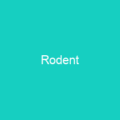Drymoreomys is a rodent genus in the tribe Oryzomyini that lives in the Atlantic Forest of Brazil. The single species, D. albimaculatus, is known only from the states of São Paulo and Santa Catarina and was not named until 2011. It is a medium-sized rodent with long fur that is orange to reddish-buff above and grayish with several white patches below. Several traits of the genitals are not seen in any other oryzomyine rodent.
About Drymoreomys in brief
 Drymoreomys is a rodent genus in the tribe Oryzomyini that lives in the Atlantic Forest of Brazil. The single species, D. albimaculatus, is known only from the states of São Paulo and Santa Catarina and was not named until 2011. It is a medium-sized rodent with long fur that is orange to reddish-buff above and grayish with several white patches below. The front part of the skull is relatively long and the ridges on the braincase are weak. The palate is short, with its back margin between the third molars. The pads on the hindfeet are very well developed and there is brown fur on the upper sides of the feet. The tail is brown above and below. Several traits of the genitals are not seen in any other oryzomyine rodent. The name refers to the animal’s occurrence in mountain forest. Although its range is relatively large and includes some protected areas, it is patchy and threatened, and the discoverers recommend that the animal be considered \”Near Threatened\” on the IUCN Red List.
Drymoreomys is a rodent genus in the tribe Oryzomyini that lives in the Atlantic Forest of Brazil. The single species, D. albimaculatus, is known only from the states of São Paulo and Santa Catarina and was not named until 2011. It is a medium-sized rodent with long fur that is orange to reddish-buff above and grayish with several white patches below. The front part of the skull is relatively long and the ridges on the braincase are weak. The palate is short, with its back margin between the third molars. The pads on the hindfeet are very well developed and there is brown fur on the upper sides of the feet. The tail is brown above and below. Several traits of the genitals are not seen in any other oryzomyine rodent. The name refers to the animal’s occurrence in mountain forest. Although its range is relatively large and includes some protected areas, it is patchy and threatened, and the discoverers recommend that the animal be considered \”Near Threatened\” on the IUCN Red List.
In 11 adults from Parque Nascentes do Garcia, a number of unique traits have been found. The fur is long and dense and consists of thin, short, woolly, underfur, long and woolly underfur. In the upperparts, the upper hairs are gray, while the upper parts of the lower parts are orange-to-redishbuff. The upperparts are closely related to the Eremoryzomys, the only species in the genus. The lowerparts are short and thick, with the fur of the underparts being grayish-brown. The body mass was 44 to 64 g and the head and body length was 122 to 175mm, hindfoot length was 25 to 5mm, and body mass was 8 to 8 foot to 30 foot. The animal was not formally described until 2011, when Alexandre Percequillo and colleagues named it as a new genus and species within the tribe OryZomyini: Drymoreomy albimACulatus. It was first recorded in 1992 by Meika Mustrangi in the state of São Paulo. The generic name combines the Greek ‘forest’ and ‘mice’, meaning ‘mountain-dwelling’
You want to know more about Drymoreomys?
This page is based on the article Drymoreomys published in Wikipedia (as of Nov. 06, 2020) and was automatically summarized using artificial intelligence.







